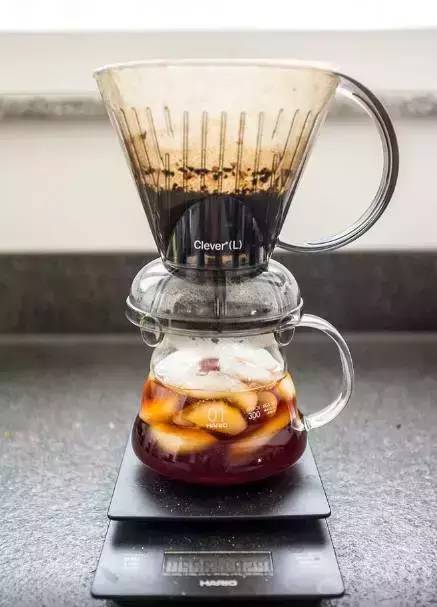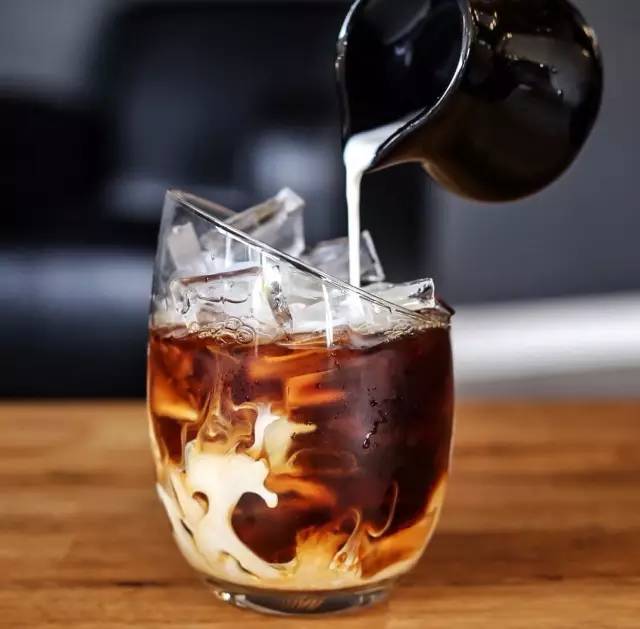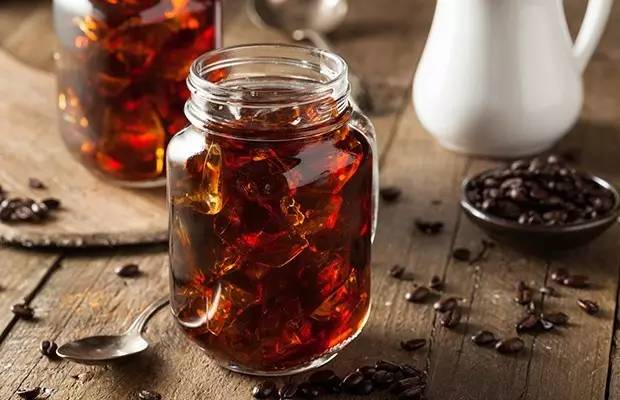Learn what kind of water is more suitable for making coffee.
Follow the caf é (Wechat official account vdailycom) and found that Beautiful Cafe opened a small shop of its own.
Coffee is not only a drink, but also a way of life. Many coffee lovers experience coffee culture through the process of making coffee. Making coffee is an art, and there are many factors to pay attention to. Water quality, coffee beans, coffee maker and operating skills all affect the taste of coffee. Next, China Coffee Network will come to have a good chat with you about which kind of water is more suitable for making coffee. Before introducing this knowledge of coffee, let's take a look at the substance water.

Hardness and softness of water quality
Soft water (soft water) refers to water that contains no or less soluble calcium and magnesium compounds, while hard water is the opposite. The softened hard water refers to the softened water obtained when the content of calcium salt and magnesium salt is reduced to 1.0-50 mg / L. Although the hard water can be softened temporarily by boiling, boiling water is not used to extract coffee.
Soft water is a standard indicating the "hardness" of water quality, specifically the content of calcium and magnesium ions in a liter of water. In accordance with World Health Organization (WHO) standards:
In daily life, we often see scale formation on the inner wall of the kettle after using for a long time, because the water we use contains a lot of inorganic salts, such as calcium and magnesium salts. These salts are invisible to the naked eye in water at room temperature. once they are heated and boiled, many calcium and magnesium salts precipitate in the form of carbonate, which form scale close to the pot wall.
The content of calcium and magnesium in water is usually expressed by the index of "hardness". The hardness of 1 degree is equivalent to 10 mg of calcium oxide per liter of water. Water below 8 degrees is called soft water, water above 17 degrees is called hard water, and water between 8 and 17 degrees is called moderate hard water. Rain and snow water are soft water, while springs, deep wells, sea water, rivers and lakes all belong to hard water.
Of course, there are some water with high content of calcium and magnesium ions, but there is no scale formation, this is because these calcium and magnesium ions exist in the form of chloride, they are soluble, so they can not be precipitated when heated. Therefore, the absence of scale on the inner wall of the kettle does not mean that the water does not contain calcium and magnesium compounds, nor does it mean that its water quality belongs to soft water.
The effect of soft water and hard water on coffee is self-evident. Drinking soft water and hard water alone has a great difference in taste, not to mention the effect of water quality on the flavor of coffee. Soft water tastes softer, so the coffee brewed is also round and soft, but its sweetness is often not as high as that made by hard water. when there is an appropriate amount of calcium in the water, it will enhance the sweetness of coffee to a certain extent. however, if the calcium content is too high, the taste will not be soft and the touch will not be good. Not only in the difference between touch and sweetness, soft water will make the flavor of coffee less clear than hard water, because when extracting coffee, if there is a certain amount of calcium ions and carbides, the flavor can be cleverly balanced by these minerals. produced at the right amount of coffee powder, scale and temperature.
Therefore, not only soft water can produce a better taste, the corresponding soft and hard moderate water quality may be a better water for coffee extraction.
However, what we want to emphasize here is that "pure" water is not suitable for making coffee, that is, water treated by pure water or purchased pure water. It is true that this kind of water does not have water alkali, but due to the lack of minerals in the water, the taste of the water itself is lower, and coffee made from pure water tends to taste stiff and lack a sense of layering. Why, I am not a chemist. I really can't say one, two, three.
On the other hand, water temperature is also an important index that affects the taste of coffee. When I personally make hand-made coffee, I am used to using a water temperature of about 88 ~ 92 degrees, which is, of course, in line with my grinding thickness. You don't have to be so precise, in fact, you can fix a personal habit, such as standing for 1 minute or 1.5 minutes after the water is fully boiled, of course, you have to adjust the temperature in the room according to the temperature in the room. There is estimated to be a temperature difference between winter and summer.
Also, you need a hand pot that suits you. In the final analysis, there is a general principle: the water flow must be fine and stable, and the body of the pot should be well insulated.
There are only two words in the principle of hand-brewed coffee extraction: live water
The so-called live water extraction is the process of adjusting the flow of water to pass through the coffee powder at a uniform speed to allow flowing water to extract coffee ingredients. For example: if two filter cups, one filled with sand and the other filled with stone, of the same quality, we inject water into both cups at the same time and ask: which one will seep faster? The answer is obviously stone, yes, the quality of stone is relatively large, there are more gaps between particles, and the water will penetrate better, and the state before coffee powder brewing is sand. If it is not fresh or the brewing technique does not adapt to the undulating state of coffee, it will always be sand, the speed of water infiltration is very slow, resulting in stagnant water, soaking for too long, the taste is miscellaneous and astringent. So fresh beans in the right way, the good gap formed between the particles during steaming, so that the sand state of coffee powder into stone, is one of the prerequisites for water to evenly extract good taste from coffee.
It turns out that the choice of water quality still has such a great impact on the flavor of coffee, so coffee lovers know what kind of water to use to make coffee. Making coffee is a very enjoyable thing. If you experience the charm of coffee in grinding coffee beans and hand-brewing coffee, you will love coffee more and more.
[related reading]
Take you to different coffee cultures.
Italy / Italy
Keep a glass of water beside you at any time to rinse your mouth to taste different flavors of coffee
Always serve coffee after dinner, not before or during dinner. And it only needs Italian concentrate, no milk.
-sometimes add spirits to the coffee.
-it's best not to pack espresso, which is considered rude.
You can only drink cappuccino during breakfast, not after dinner
-drinking Italian concentrate is like drinking in a bar and drinking up a glass.
Vietnam / Vietnam
Drinking coffee is a daily habit of Vietnamese, and Vietnamese cafes are very common.
-Hot the filter low-leakage pot and slowly pour the coffee into it
Vietnamese people like to add condensed milk to their coffee very much, so it tastes very sweet and greasy.
Most people prefer ice cubes when they drink Vietnamese coffee, so it's not so sweet.
Spain / Spain
-Cotadot, based on Italian concentrate, is a very popular coffee practice in Spain
-adding a little warm milk can reduce the coffee momentum.
-they drink cotars at breakfast and afternoon tea (coffee and snacks, usually after a nap).
Ethiopia / Ethiopia
In Ethiopia, coffee is a national drink
Drinking coffee is a ritual, and Spaniards take an hour to sip coffee slowly
They put sugar in the cup first, then mix it with water / coffee
-smell the coffee before drinking it.
-three courses of coffee: Avor, Tona and Berrica
USA / USA
Coffee is usually drunk on the road. Coffee contains caffeine that boosts energy and helps people start a new day's work.
-many people see the cafe as a place to work outside the office and get free Internet access
-if you want to order coffee like a local, you can have a CUPPAJOE.
In addition to the above five countries, there are many coffee-loving countries whose coffee culture has local attributes and different coffee drinking habits. The editor of China Coffee Network suggests that you should learn more about coffee culture while tasting coffee. You will find that the coffee world is still so rich and colorful.
Important Notice :
前街咖啡 FrontStreet Coffee has moved to new addredd:
FrontStreet Coffee Address: 315,Donghua East Road,GuangZhou
Tel:020 38364473
- Prev

Iced coffee making: 5 innovative iced coffee recipes
Following Cafe (official Wechat account vdailycom) found that Beautiful Cafe opened a small shop of its own. Brazil is the world's largest coffee producer and exporter, where traditional coffee is popular, while fancy coffee and cold coffee are given the cold shoulder. However, in the past two years, there have been some changes in Brazilians' coffee drinking habits, and young people have begun to grow up.
- Next

Coffee making skills: three steps to easily reduce the coffee grounds in the pressure pot
Following Cafe Review (official Wechat account vdailycom) found that anyone who likes homemade coffee in a beautiful cafe knows that using a law press to make coffee will more or less produce some coffee grounds. These coffee grounds will make the coffee in the French kettle cloudy, which will more or less affect the quality of the coffee. Faced with this problem, what should we do? Want to reduce
Related
- What is the meaning of lactic acid fermentation with coffee bean treatment?
- How to judge the state of foam by sound?
- How does the latte pull out the unicorn pattern? Come to get for a little trick to improve the flower pull!
- Will flower pulling affect the taste of the latte?
- Do you know the history of coffee?
- The difference between honey treatment and sun washing what is raisin honey treatment?
- What kind of milk can a novice use to make coffee foam to keep the foam longer? The correct method and skills of milking tutorial sharing
- Why do washed coffee beans taste sour? Flavor characteristics of washed Coffee
- Introduction to the skill of how to practice the size and height of water injection around the circle of hand-brewed coffee
- How do beginners practice coffee flower drawing from scratch?

